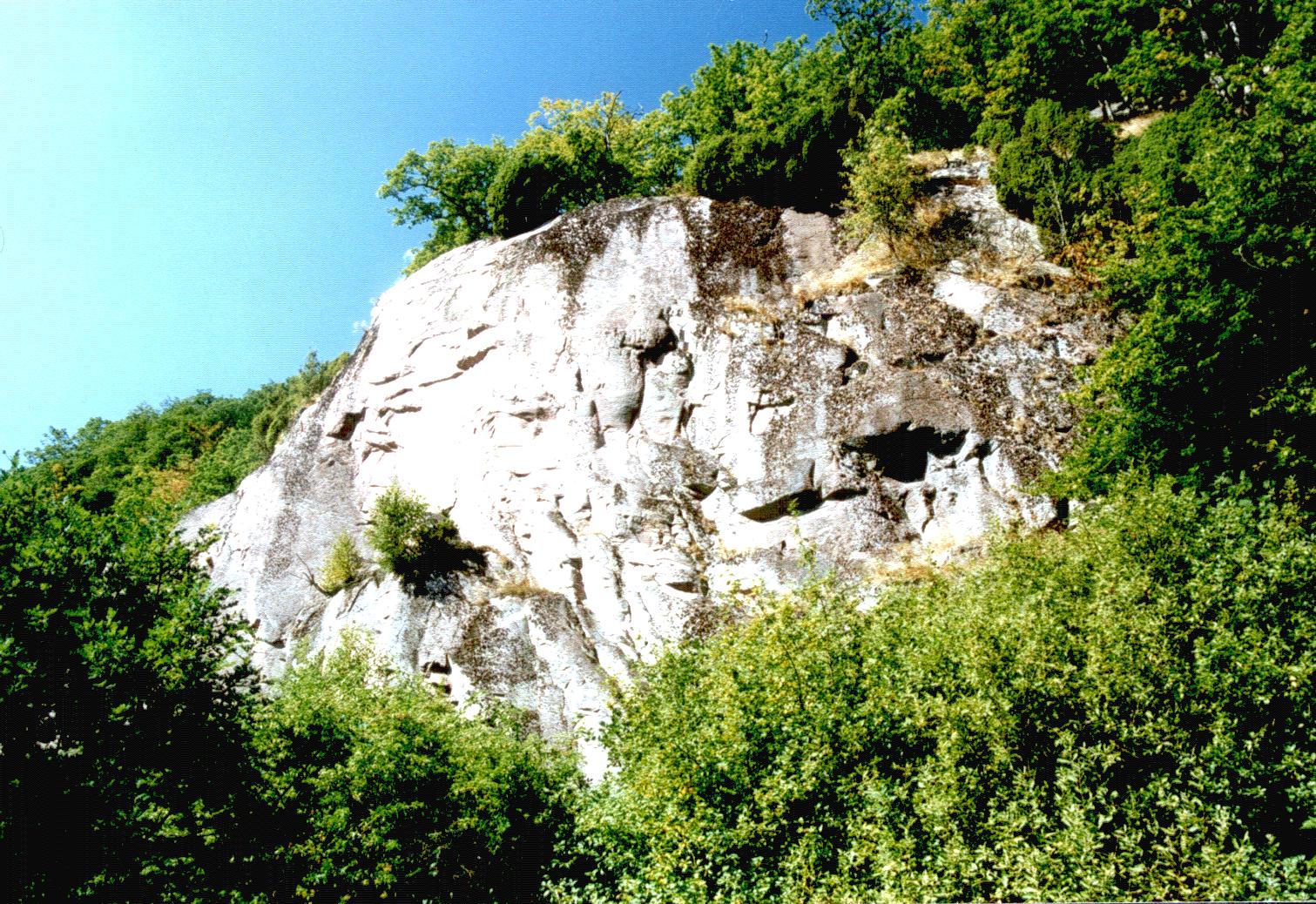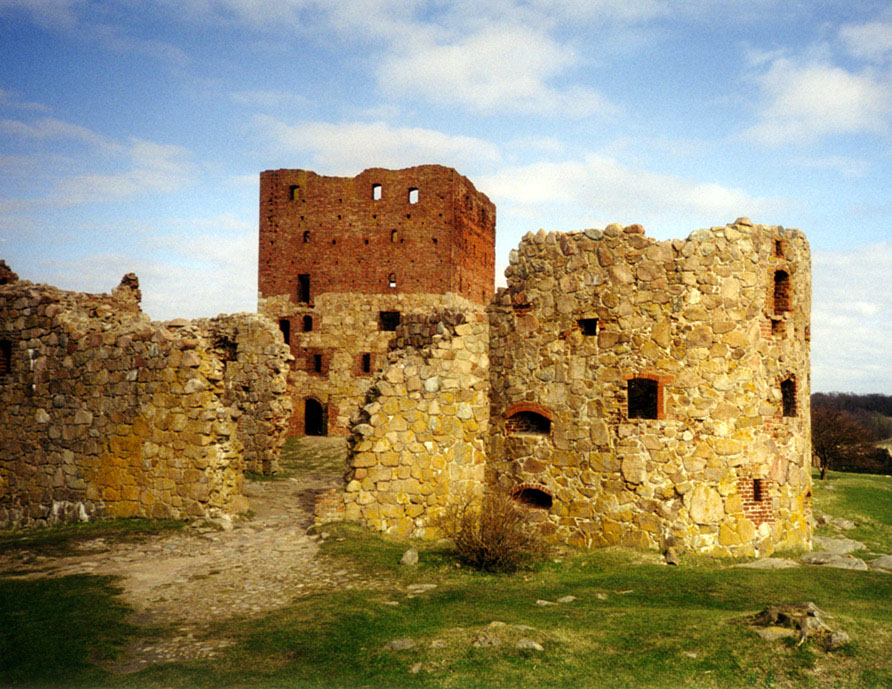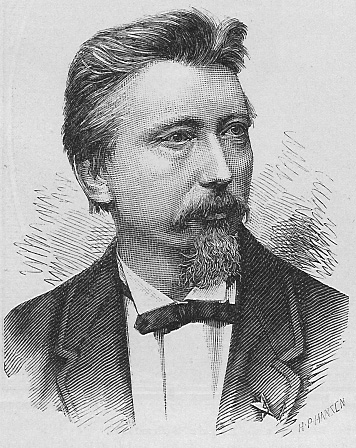|
Ekkodalen
Ekkodalen (Echo Valley) on Bornholm is Denmark's longest rift. It stretches 12 km from Vallensgård Mose through Almindingen, Flæskedal, Kløvedal and Kelseådal to Saltuna on Bornholm's northeast coast. History Echo Valley was originally named Kodalen (Cow Valley), probably because by the royal edict of 1658 the peasants had obtained rights to free grazing for their cattle there. The first time the name Ekkodalen appears on a map was in 1746 when someone added EC before Kodalen changing it to Eckodalen. Others argue that it was Bornholm's first forester, Hans Rømer, who found the name. The steep cliffs on one side of Ekkodalen are called Styrtebakkerne. The name was originally Stortebakkene, an old Bornholm term for a ridge with a steep, vertical rock face. In Ekkodalen there are memorials to Bornholm philanthropist Marie Kofoed and to Hans Rømer, the forester. There is also one on the cliff face where a young scout, Johannes V. Andersen, died after a fall in 1947. ... [...More Info...] [...Related Items...] OR: [Wikipedia] [Google] [Baidu] |
Almindingen
Almindingen ("the common") is one of the largest forests in Denmark. It is located in the centre of the island of Bornholm. The forest covers , making it Denmark's third largest. Though it was at one time common grazing land for cattle, it was fenced in for forestry in 1809 by Hans Rømer, the forest supervisor. As a result, by the beginning of the 20th century, Bornholm had become Denmark's most forested region. Bornholm's highest point is Rytterknægten at , where there is a memorial to Frederick VII of Denmark and Countess Danner's visit to the island in 1851. In 2012, the Nature Agency brought seven European bison from a Polish primeval forest to a paddock in Almindingen, marking the first time in 2,500 years that Europe's heaviest land-living mammals were in Denmark. ''Den Store Da ... [...More Info...] [...Related Items...] OR: [Wikipedia] [Google] [Baidu] |
Bornholm
Bornholm () is a Danish island in the Baltic Sea, to the east of the rest of Denmark, south of Sweden, northeast of Germany and north of Poland. Strategically located, Bornholm has been fought over for centuries. It has usually been ruled by Denmark, but also by Sweden and by Lübeck. The ruin of Hammershus, at the northwestern tip of the island, is the largest medieval fortress in northern Europe, testament to the importance of its location. Bornholm and Ertholmene comprise the last remaining Danish territory in Skåneland east of Øresund, having been surrendered to Sweden in 1658, but regained by Denmark in 1660 after a local revolt. The island is known as ("sunshine island") because of its weather and ("rock island") because of its geology, which consists of granite, except along the southern coast. The heat from the summer is stored in the rock formations and the weather is quite warm until October. As a result of the climate, a local variety of the common fig, k ... [...More Info...] [...Related Items...] OR: [Wikipedia] [Google] [Baidu] |
Hans Christian Ørsted
Hans Christian Ørsted ( , ; often rendered Oersted in English; 14 August 17779 March 1851) was a Danish physicist and chemist who discovered that electric currents create magnetic fields, which was the first connection found between electricity and magnetism. Oersted's law and the oersted unit (Oe) are named after him. A leader of the Danish Golden Age, Ørsted was a close friend of Hans Christian Andersen and the brother of politician and jurist Anders Sandøe Ørsted, who served as Prime Minister of Denmark from 1853 to 1854. Early life and studies Ørsted was born in Rudkøbing in 1777. As a young boy he developed an interest in science while working for his father, who owned the local pharmacy. He and his brother Anders received most of their early education through self-study at home, going to Copenhagen in 1793 to take entrance exams for the University of Copenhagen, where both brothers excelled academically. By 1796, Ørsted had been awarded honors for his pape ... [...More Info...] [...Related Items...] OR: [Wikipedia] [Google] [Baidu] |
Vilhelm Bergsøe
Jörgen Vilhelm Bergsøe (8 February 1835 - 26 June 1911) was a Danish entomologist who moved to Italy and became a novelist and poet. Bergsøe was born in Copenhagen Copenhagen ( or .; da, København ) is the capital and most populous city of Denmark, with a proper population of around 815.000 in the last quarter of 2022; and some 1.370,000 in the urban area; and the wider Copenhagen metropolitan ar .... He studied natural sciences, specializing in entomology and graduated in 1860 with a thesis was on a parasitic copepod ''Philichthys xiphiae'' described by Japetus Steenstrup. He later published a book on ''Pictures of Insect Life from Field and Wood'' (1915) and various papers, such as on centipedes, describing several new species. He suffered from poor eyesight, gave up entomology, and moved to Italy for better health and stayed on in Rome, Naples and Sicily writing historically located novels in the style of Meïr Aron Goldschmidt, A. M. Goldschmidt such as ''Itali ... [...More Info...] [...Related Items...] OR: [Wikipedia] [Google] [Baidu] |
Geography Of Bornholm
Geography (from Ancient Greek ; combining 'Earth' and 'write', literally 'Earth writing') is the study of the lands, features, inhabitants, and phenomena of Earth. Geography is an all-encompassing discipline that seeks an understanding of Earth and its human and natural complexities—not merely where objects are, but also how they have changed and come to be. While geography is specific to Earth, many concepts can be applied more broadly to other celestial bodies in the field of planetary science. Geography has been called "a bridge between natural science and social science disciplines." Origins of many of the concepts in geography can be traced to Greek Eratosthenes of Cyrene, who may have coined the term "geographia" (). The first recorded use of the word γεωγραφία was as the title of a book by Greek scholar Claudius Ptolemy (100 – 170 AD). This work created the so-called "Ptolemaic tradition" of geography, which included "Ptolemaic cartographic theory." ... [...More Info...] [...Related Items...] OR: [Wikipedia] [Google] [Baidu] |




